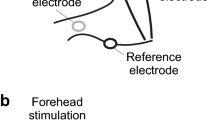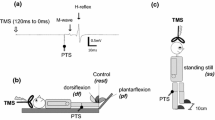Abstract
Coordination between motions of the head and the hindlimb paw ipsilateral to the stimulated pinna were assessed during the scratch cycle in freely moving cats. Motor patterns were determined by electromyographic (EMG) recordings made from epimysial-patch electrodes surgically implanted on the biventer cervicis (BC), complexus (CM), obliquus capitis inferior (OC), and splenius (SP) muscles and by fine-wire EMG electrodes implanted in two ankle muscles, medial gastrocnemius (MG), and tibialis anterior (TA). To assess head motions during the three phases of the scratch cycle (precontact, contact, postcontact), several responses were filmed, and in some cats an in vivo force transducer was implanted on an ankle extensor muscle (MG or plantaris, PL) to determine the tension profile during the scratch cycle. During the scratch cycle, the head's trajectory was usually characterized by a small oscillation in which the head was pushed away during paw contact (as hindlimb joints extended) and then repositioned during the noncontact phases (as hindlimb joints flexed). Neck muscle activity did not occur during all responses or during all cycles of a single multicycle scratch response, and when it occurred, neck muscle EMG was characterized as phasic (a single burst during the cycle) or tonic (low-level activity during the entire cycle). Neck muscles ipsilateral (i) to the scratching limb exhibited phasic bursts more than contralateral (c) muscles, and phasic activity was most frequently observed in the iBC, iSP, iOC, and cOC muscles. The cOC was reciprocally active with the ipsilateral muscles, and its burst coincided with the postcontact phase and the ankle flexor (TA) burst. The ipsilateral muscles (iOC, iSP, iBC) were active during paw contact, and the termination of all three bursts occurred synchronously just after peak tension of the ankle extensor was reached. The iBC was active before the onset of paw contact and may have been responsible for repositioning the head, along with the cOC, during the precontact phase. The iOC became active after the onset of paw contact (22 ms) and was recruited more often when the peak extensor tendon force was high (10–16 N). The iSP, in contrast, was active during the contact phase of most scratch cycles examined and its recruitment appeared to be unrelated to tendon forces. Our data suggest that phasic neck muscle activity is not obligatory during the cat scratch response, but is related to certain conditions such as a higher than average tendon force of an ankle extensor during contact and the need to reposition the head during the noncontact phases of the cycle. During contact it is possible that active muscle contraction helps to minimize head motion to provide a stable contact surface for the paw, thereby maximizing the possibility of the scratch stimulus being dislodged from the pinna. Possible neural mechanisms, both reflexes and central commands, responsible for coordinating motions of the head and hindlimb during the scratch cycle are discussed.
Similar content being viewed by others
References
Abrahams VC, Richmond FJR (1988) Specialization of sensorimotor organization in the neck muscle system. Prog Brain Res 76:125–135.
Arshavsky YI, Gelfand IM, Orlovsky GN, Pavlova GA (1978) Messages conveyed by spinocerebellar pathways during scratching in the cat. II. Activity of neurons in the ventral spinocerebellar tract. Brain Res 151:493–406
Baev KD, Degtyarenko AM, Zavadskaya TV, Kostyuk PG (1981) Activity of lumbo-sacral interneurons during fictitious scratching. Neurophysiol Kiev 13:45–52
Barajon I, Gossard J-P, Hultborn H (1992) Induction of fos expression in the spinal rhythm generator for scratching. Brain Res 588:168–172
Berkinblit MB, Degliagina TG, Feldman AG, Gelfand IM, Orlovsky GN (1978) Generation of scratching. I. Activity of spinal interneurons during scratching. J Neurophysiol 41:1040–1057
Bradley NS, Smith JL (1988) Neuromuscular patterns of Stereotypic hindlimb behaviors in the first two postnatal months. III. Scratching and the paw-shake response in kittens. Dev Brain Res 38:69–82
Buford JA, Smith JL, Zernicke RF (1990) Adaptive control for backward quadrupedal walking. I. Posture and hindlimb kinematics. J Neurophysiol 64:745–755
Carlson-Kuhta P (1992) Neuromotor control of the scratch response in the cat. Doctoral dissertation, University of California, Los Angeles
Carlson-Kuhta P, Smith JL (1990a) Medial gastrocnemius tendon forces and muscle activity during cat scratching. Soc Neurosci Abstr 16:890
Carlson-Kuhta P, Smith JL (1990b) Scratch responses in normal cats: hindlimb kinematics and muscle synergies. J Neurophysiol 64:1653–1667
Carlson-Kuhta P, Smith JL (1991) Integrative patterns of dorsal neck and hindlimb muscle activities during the scratch cycle. Soc Neurosci Abstr 17:121
Carlson-Kuhta P, Smith JL (1992) Importance of posture and head movement during hindlimb scratching in the cat. In: Woollacott M, Horak F (eds) Posture and gait: control mechanisms. University of Oregon Books, Eugene, pp 63–66
Deliagina TG, Feldman AG, Gelfand IM, Orlovsky GN (1975) On the role of central pattern and afferent inflow in the control of scratching movements in the cat. Brain Res 100:297–313
Deliagina TG, Orlovsky GN, Perret C (1981) Efferent activity during fictitious scratch reflex in the cat. J Neurophysiol 45:595–604
Deliagina TG, Orlovsky GN, Pavlova GA (1983) The capacity for generation of rhythmic oscillations is distributed in the lumbosacral spinal cord of the cat. Exp Brain Res 53:81–90
Duysens J, Pearson KG (1980) Inhibition of flexor burst generation by loading ankle extensor muscles in walking cats. Brain Res 187:321–332
Fowler EG, Gregor RJ, Hodgson JA, Roy RR (1993) Relationship between ankle muscle and joint kinetics during the stance phase of locomotion in the cat. J Biomech 26:465–483
Gelfand IM, Orlovsky GN, Shik ML (1988) Locomotion and scratching in tetrapods. In: Cohen AH, Rossignol S, Grillner S (eds) Neural control of rhythmic movements in vertebrates. Wiley, New York, pp 167–199
Giszter S, McIntry J, Bizzi E (1989) Kinematic strategies and sensorimotor transformations in the wiping movements of frogs. J Neurophysiol 62:760–767
Gossard J-P, Brownstone RM, Barajon I, Hultborn H (1994) Transmission in a locomotor-related group Ib pathway from hindlimb extensor muscles in the cat. Exp Brain Res 98:213–228
Herzog W, Leonard TR, Guimares, ACS (1993) Forces in gastrocnemius, soleus, and plantaris tendons of the freely moving cat. J Biomech 26:945–953
Jami L (1992) Golgi tendon organs in mammalian skeletal muscle: functional properties and central actions. Physiol Rev 72:623–666
Jankowska E (1992) Interneuronal relay in spinal pathways from proprioceptors. Prog Neurobiol 38:335–378
Keirstead SA, Rose PK (1988) Monosynaptic projections of single muscle spindle afferents to neck motoneurons in the cat. J Neurosci 8:3945–3950
Keshner EA, Peterson BW (1988) Motor control strategies underlying head stabilization and voluntary head movements in humans and cats. Prog. Brain Res. 76:329–339
Loeb, GE, Yee WJ, Pratt CA, Chanaud CM, Richmond FJR (1987) Cross-correlation of EMG reveals widespread synchronization of motor units during some slow movements in intact cats. J Neurosci Methods 21:239–249
Mori S (1987) Integration of posture and locomotion in acute decerebrate cats and in awake freely moving cats. Prog Neurobiol 28:161–195
Mortin LI, Keifer J, Stein PSG (1985) Three forms of the scratch reflex in the spinal turtle: movement analysis. J Neurophysiol 53:1501–1516
Pearson KG, Collins DF (1993) Reversal of the influence of group Ib afferents from plantaris on activity in medial gastrocnemius muscle during locomotor activity. J Neurophysiol 70:1009–1017
Perell KL, Gregor RJ, Buford JA, Smith JL (1993) Adaptive control for backward quadrupedal walking. IV. Hindlimb kinetics during stance and swing. J Neurophysiol 70:2226–2240
Peterson BW, Goldberg J, Bilotto G, Fuller JH (1985) Cervicocollic reflex: its dynamic properties and interaction with vestibular reflexes. J Neurophysiol 54:90–109
Pratt CA, Fung J, Jacobs R (1993) Evidence of positive feedback during standing in intact cats. Soc Neurosci Abstr 19:142
Reinsch CH (1967) Smoothing by spline functions. Numer Math 10:177–183
Richmond FJR, Abrahams VC (1975) Morphology and distribution of muscle spindles in dorsal muscles of the cat neck. J Neurophysiol 38:1322–1339
Richmond FJR, Vidal PP (1988) The motor system: joints and muscles of the neck. In: Peterson BW, Richmond FJR (eds) Control of head movement. Oxford University Press, New York, pp 1–21
Richmond FJR, Bakker GJ, Bakker DA, Stacey MJ (1986) The innervation of tandem muscle spindles in the cat neck. J Comp Neurol 245:483–497
Richmond FJR, Thomson DB, Loeb GE (1992) Electromyo graphic studies of neck muscles in the intact cat. Exp Brain Res 88:41–58
Selbie WS, Thomson DB, Richmond FJR (1993) Sagittal-plane mobility of the cat cervical spine. J Biomech 26:917–927
Sherif MH, Gregor RJ, Lui LM, Roy RR, Hager CL (1983) Correlation of myoelectric activity and muscle force during selected cat treadmill locomotion. J Biomech 16:691–701
Sherrington CS (1906) Observations on the scratch-reflex in the spinal dog. J Physiol (Lond) 34:1–50
Sherrington CS (1910) Notes on the scratch-reflex of the cat. Q J Exp Physiol 3:213–220
Sherrington CS (1917) Reflexes elicitable in the cat from pinna, vibrissæ, and jaws. J Physiol (Lond) 51:401–431
Smith JL, Carlson-Kuhta P (1993) Comparison of neck muscle EMG-patterns during three Stereotypic head motions. Soc Neurosci Abstr 19:552
Vidal PP, Graf W, Berthoz A (1986) The orientation of the cervical vertebral column in unrestrained awake animals. I. Resting position. Exp Brain Res 61:549–559
Walmsley B, Hodgson JA, Burke RE (1978) Forces produced by medial gastro-cnemius and soleus muscles during locomotion in freely moving cats. J Neurophysiol 41:1203–1216
Whiting WC, Gregor RJ, Roy RR, Edgerton VR (1984) A technique for estimating mechanical work of individual muscles in the cat during treadmill locomotion. J Biomech 17:685–694
Wilson VJ, Peterson BW (1988) Vestibular and reticular projections to the neck. In: Peterson BW, Richmond FJR (eds) Control of head movement. Oxford University Press, New York, pp 129–145
Author information
Authors and Affiliations
Rights and permissions
About this article
Cite this article
Carlson-Kuhta, P., Smith, J.L. Coordination between head and hindlimb motions during the cat scratch response. Exp Brain Res 101, 279–290 (1994). https://doi.org/10.1007/BF00228748
Received:
Accepted:
Published:
Issue Date:
DOI: https://doi.org/10.1007/BF00228748




